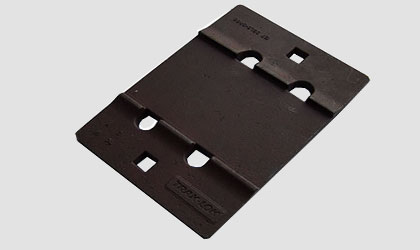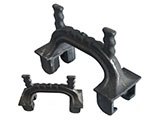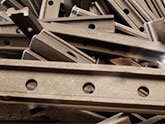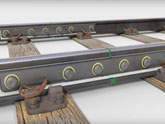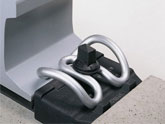Steel Rail
Steel rail, mainly used on the railway, and matched with the switch, to ensure that the train can walk without turning. The railway track is usually composed of two parallel rails which fixed on the sleepers. Railway track is made up of rail brace, fastener, rail pressure, plywood, elastic strip, railway spikes and other railway fasteners.The steel rail's function is to guide the vehicle wheels forward, withstand the enormous pressure of the wheel, and transfer a part of pressure to the sleepers. So steel rails must provide a continuous, smooth, rolling surface with a minimum friction force, to ensure the stable operation of trains. In the electrified railway or automatic block section, the steel rail can also be used as a track circuit.
AGICO is professional steel rail manufacture, It Is one of the most powerful railroad fasteners suppliers in China. We are available to produce steel rails of various standards used in coal mining, main railway lines, factories, cranes, etc. There are light steel rails, heavy steel rails, crane steel rails, and over heavy steel rail.
Steel rail is the key to ensure the safe running of the train, and its main functions are as follows:
1. Steel rails bear the weight of the wheels and wear2. Transfer the pressure to the sleeper
3. To bear the weight pressure repeatedly
Types of rail track
China1.Crane rail: QU120,QU100,QU80,QU70. They are most consist of manganese steel.
2.Heavy rail: the 38kg、43kg、50kg standard are widely used. Besides, as to some lines with high speed and vast capacity, they all use the 60kg rail tracks.
3.Light rail: light rail can also classified into two types, GB (China national standards) of 9、12、15、22、30kg/m and YB (Metallurgy Department Standard) of 8、18、24kg/m and so on.
Abroad
Among the rail track market in the world, there are many typical types. For example, the BS series (such as 90A, 80A, 75A, 75R, 60A and so on) of British, the DIN series of Germany, the ASCE series of America, the JIS series of Japan and the UIC series of International Union of Railways.
Specifications of typical rail tracks
In order to meet the different requirements of railway system, the rail tracks can divided into many types. According to the railway track weight, the 43kg, 50kg and 60kg are widely used in the railway transportation.43kg/m
| project | 43kg/m rail steel |
| Height of steel rail | ±0.8 |
| Width of railhead | ±0.5 |
| Rail on cross section | |
| Joint plate mounting surface slope |
+1.0 -0.5 |
| Joint plate mounting surface height | ±0.6 |
| The thickness of the rail waist |
+1.0 -0.5 |
| Rail bottom width |
+1.0 -2.0 |
| Rail bottom edge thickness | |
| Rail bottom concave | |
| Section slope (vertical, horizontal direction) | <=1.0 |
| Section of asymmetric | ±1.5 |
| Length (temperature of 20 degrees) |
| project | number | unit | |
| weight of per meter | 44.563 | kg | |
| sectional area | 57 | cm² | |
| the distance between center of gravity and rail base | 6.9 | cm | |
| moment of inertia on horizontal axis | 1489 | cm4 | |
| moment of inertia on vertical axis | 260 | cm4 | |
| the lower section coefficient | 217.3 | cm3 | |
| the upper section coefficient | 208.3 | cm3 | |
| the bottom section coefficient | Left45.0 right 45.0 | cm3 | |
| metal distribution----railhead | 42.83 | % | |
| metal distribution----rail web | 21.31 | % | |
| metal distribution----rail base | 35.86 | % |


50kg/m
| project | 50-75/m |
| Height of steel rail | ±0.6 |
| Width of railhead | ±0.5 |
| Rail on cross section | |
| Joint plate mounting surface slope |
+1.0 -0.5 |
| Joint plate mounting surface height |
+0.6 -0.5 |
| The thickness of the rail waist |
+1.0 -0.5 |
| Rail bottom width |
+1.0 -1.5 |
| Rail bottom edge thickness |
+0.75 -0.5 |
| Rail bottom concave | |
| Section slope (vertical, horizontal direction) | <=0.8 |
| Section of asymmetric | ±1.2 |
| Length (temperature of 20 degrees) |
| project | number | unit |
| weight of per meter | 51.514 | kg |
| sectional area | 65.8 | cm² |
| the distance between center of gravity and rail base | 7.1 | cm |
| moment of inertia on horizontal axis | 2037 | cm4 |
| moment of inertia on vertical axis | 377 | cm4 |
| the lower section coefficient | 287.2 | cm3 |
| the upper section coefficient | 251.3 | cm3 |
| the bottom section coefficient | left&right 57.1 | cm3 |
| metal distribution----railhead | 38.68 | % |
| metal distribution----rail web | 23.77 | % |
| metal distribution----rail base | 37.55 | % |
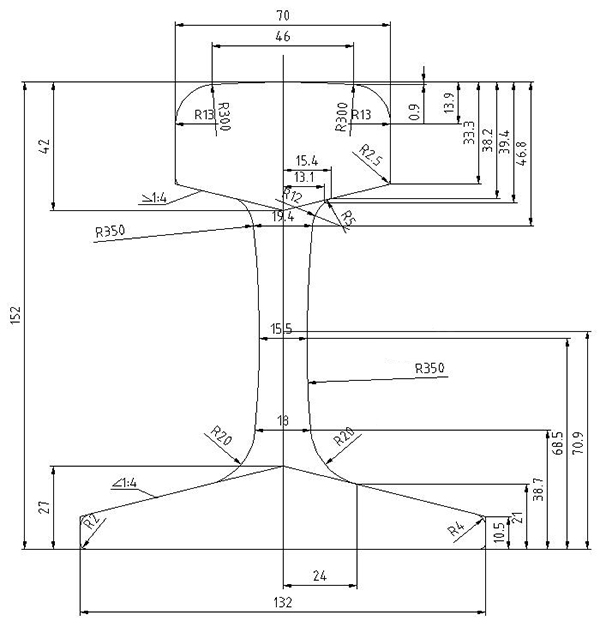

Get In Touch
We receive enquiries in English, Español (Spanish), Русский язык (Russian), Français (French) and العربية (Arabic). Our professional team will reply to you within one business day. Please feel FREE to contact us!


